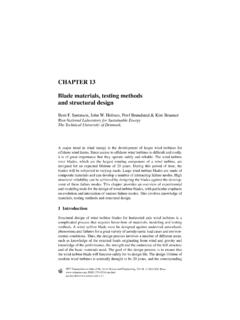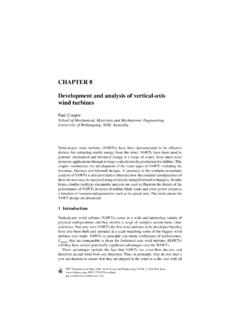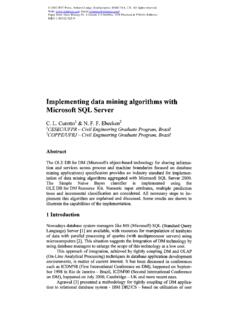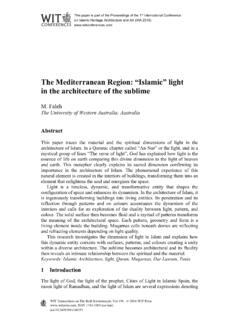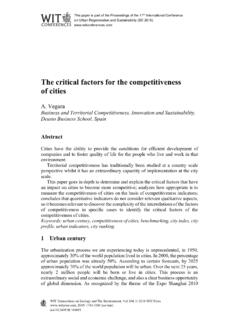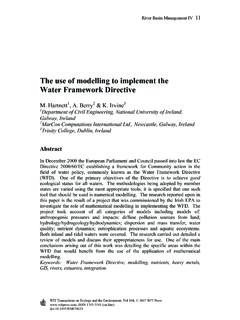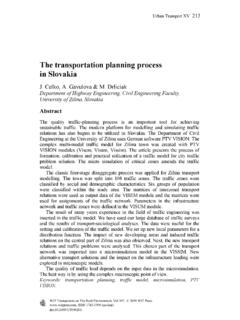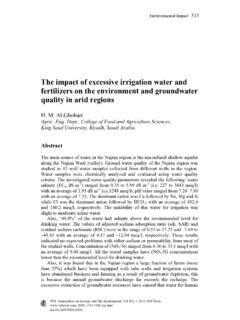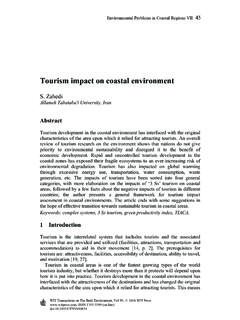Transcription of CHAPTER 4 Steam power plants - WIT Press
1 CHAPTER 4 Steam power plantsE. KhalilDepartment of Mechanical power Engineering, Cairo University, Cairo, effi cient utilization of fossil energy in power generation together with low pollution in conventional thermal power plants is a topic that is gaining interest internationally. The energy availability and sustainability scenario is an area of growing interest and demand in many countries worldwide due to the greater desire to enhance standards of living, increase productivity and preserve a clean environment.
2 Effi cient energy use is favorable for better productivity, product quality, costs, and quality of human life but the use of energy adversely impacts our envi-ronment. The fundamental concepts of power generation had been refi ned to enhance the power generation effi ciency through the use of modern techniques of waste heat recovery and co-generation. This CHAPTER summarizes the basic power cycles in Steam power plants and outlines the various methods of improvement.
3 The main goal of effi cient power generation is, among others, to rationalize the use of fossil fuels and enhance the combustion effi ciencies. This is outlined in this CHAPTER through a review of the various combustion modeling techniques for furnace fl ames under steady and time dependent confi gurations. The ability of numerical computations to predict the boiler furnace thermal behavior is an ultimate goal. The heat transfer to furnace walls through thermal radiation is reviewed briefl y to demonstrate the present capabilities.
4 Boiler furnace walls are subject to the major problems of fouling that result in deterioration of the per-formance and drastic reduction of the heat transfer characteristics. This work briefl y highlights the fouling problem in power plant water walls and proposes a monitoring, inspection, and maintenance schedule. The information provides a quick guide on the commonly faced operation problems and methods to enhance energy conversion effi ciency. , ISSN 1755-8336 (on-line) WIT Transactions on State of the Art in Science and Engineering, Vol , 20 WIT Press4208 Thermal Engineering in power Systems1 IntroductionCentralized power generation became possible when it was recognized that alternating current power lines can transport electricity at low costs across great distances by taking advantage of the ability to raise and lower the voltage using power transformers.
5 Since 1881, electricity has been generated for the purpose of powering human technologies from various sources of energy. The fi rst power plants were run on water power or coal, and today we rely mainly on coal, nuclear, natural gas, hydroelectric, and petroleum with a small amount from solar energy, tidal harnesses, wind generators, and geothermal sources. Rotating turbines attached to electrical generators produce most commercially available electricity. Turbines are driven by a fl uid, which acts as an intermediate energy carrier.
6 The fl uids typically used are: Steam in Steam turbines Water is boiled by nuclear fi ssion or the burning of fossil fuels (coal, natural gas, or petroleum). Some newer plants use the sun as the heat source: solar parabolic troughs and solar power towers concentrate sunlight to heat a heat transfer fl uid, which is then used to produce Steam . Another renewable source of heat used to drive a turbine is geothermal power . Either Steam under pressure emerges from the ground and drives a turbine or hot water evaporates a low-boiling liquid to create vapor to drive a in hydraulic turbines Turbine blades are acted upon by fl owing water, produced by hydroelectric dams or tidal Most wind turbines generate electricity from naturally occurring wind.
7 Solar updraft towers use wind that is artifi cially produced inside the chimney by heating it with gases in gas turbines Turbines are driven directly by gases produced by the combustion of natural gas or cycle gas turbine plants are driven by both Steam and gas. They generate power by burning natural gas in a gas turbine and use residual heat to generate additional electricity from Steam . These plants offer effi ciencies of up to 60%.Various other technologies have been studied and developed for power generation.
8 Solid-state generation (without moving parts) is of particular interest in portable applications. This area is largely dominated by thermoelectric (TE) devices, though thermionic (TI) and thermo-photovoltaic (TPV) systems have been developed as well. Typically, TE devices are used at lower temperatures than TI and TPV systems. Piezoelectric devices are used for power generation from mechanical strain, particularly in power harvesting. Betavoltaics are another type of solid-state power generator, which produces electricity from radioactive decay.
9 Fluid-based magnetohydrodynamic power generation has been studied as a method for extract-ing electrical power from nuclear reactors and also from more conventional fuel combustion systems. Electrochemical electricity generation is also important in portable and mobile applications. Currently, most electrochemical power comes from closed electrochemical cells ( batteries ), which are arguably utilized more , ISSN 1755-8336 (on-line) WIT Transactions on State of the Art in Science and Engineering, Vol , 20 WIT Press4208 Steam power plants 101as storage systems than generation systems, but open electrochemical systems, known as fuel cells, have been undergoing a great deal of research and develop-ment in the last few years.
10 Fuel cells can be used to extract power either from natural fuels or from synthesized fuels (mainly electrolytic hydrogen) and so can be viewed as either generation systems or storage systems depending on their and parameters affecting the selection of Steam power plant capacities and sites [1]:1. Types of service (base load or peak load).2. Location (relative to water and fuel).3. Space available (each power plant has a certain area/unit energy produced).4. Reliability: Steam turbine life is extremely long.
